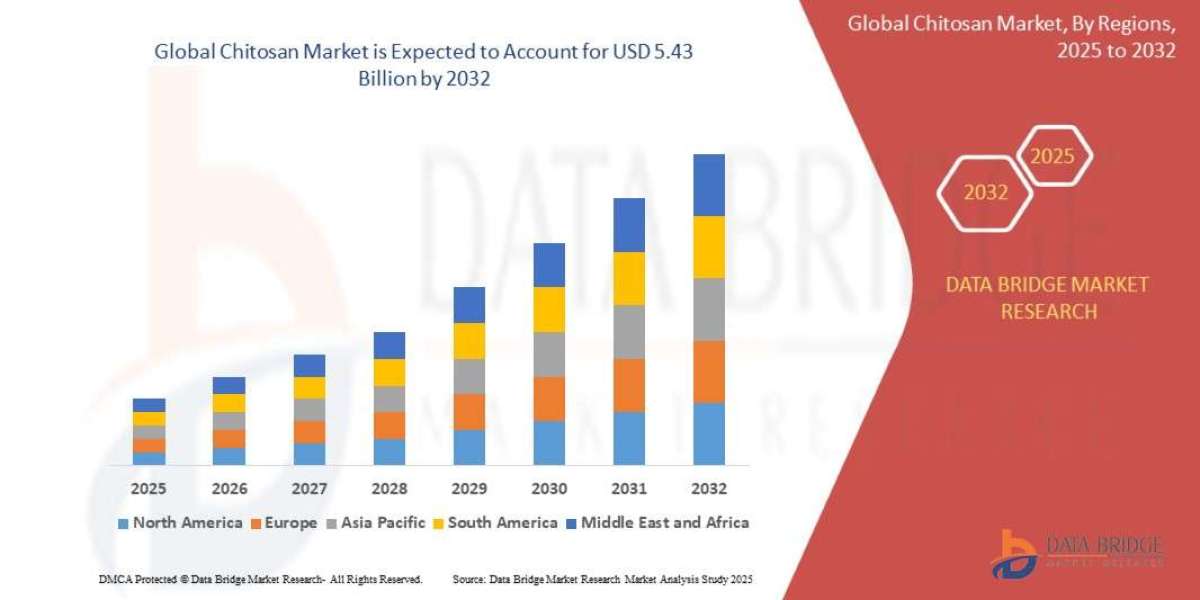Executive Summary:
- The global chitosan market was valued at USD 1.94 billion in 2024 and is expected to reach USD 5.43 billion by 2032
- During the forecast period of 2025 to 2032 the market is likely to grow at a CAGR of 13.70%,
Market Overview: Defining the Biopolymer Landscape
Chitosan is a linear polysaccharide composed of randomly distributed $\beta-(1ightarrow 4)$-linked D-glucosamine (deacetylated unit) and $\text{N}$-acetyl-D-glucosamine (acetylated unit). It is produced commercially by the deacetylation of chitin, the second most abundant natural polymer after cellulose, found in crustacean shells, insect cuticles, and fungal cell walls.
Key Segments
The market is segmented across multiple dimensions, each with distinct growth dynamics:
| Segmentation Axis | Dominant Segment (2024/2025) | Fastest Growing Segment |
| Source | Shrimp Shells ($\approx 65\%-70\%$ share) | Fungal/Mycelium-Derived (Vegan Chitosan) |
| Grade | Industrial Grade | Pharmaceutical/Biomedical Grade |
| Application | Water Treatment (Largest Volume) | Biomedical & Pharmaceuticals (Highest CAGR) |
| Region | Asia Pacific (Largest Volume) or North America (Largest Value Share, depending on source) | Asia Pacific (Highest CAGR) |
Core Market Drivers
Surging Demand for Sustainable Water Treatment: Chitosan is an effective, non-toxic, and biodegradable flocculant/coagulant used to remove suspended solids, heavy metal ions, and organic pollutants from industrial and municipal wastewater, replacing traditional, less environmentally friendly chemicals.
Advancements in Drug Delivery: Its unique mucoadhesive and bioadhesive properties make it a premier material for drug excipients, improving the bioavailability and targeted release of therapeutics, particularly in oral and nasal applications. This is fueling high growth in the pharmaceutical segment.
Expansion in Biomedical & Wound Care: Chitosan-based products, like hemostatic dressings (e.g., Axiostat, HemCon), leverage the polymer's innate antimicrobial and hemostatic properties for fast, effective trauma care.
Rise of Bio-Based Agrochemicals: Strict regulations against synthetic pesticides and the consumer-driven push for organic farming have positioned chitosan as a promising natural biopesticide and plant growth stimulant.
Market Size & Forecast: A Decade of Double-Digit Growth
- The global chitosan market was valued at USD 1.94 billion in 2024 and is expected to reach USD 5.43 billion by 2032
- During the forecast period of 2025 to 2032 the market is likely to grow at a CAGR of 13.70%,
For More Information Visit https://www.databridgemarketresearch.com/reports/global-chitosan-market
Key Trends & Innovations: The Shift to High-Functionality
1. The Vegan/Fungal Chitosan Revolution ?
The traditional supply chain relies on shellfish waste, which presents challenges related to seasonal availability, batch-to-batch variation, and, critically, shellfish allergen concerns in food and cosmetic applications.
Innovation: Companies like KitoZyme have pioneered the industrial-scale production of fungal-derived (vegan) chitosan from sources like Aspergillus niger.
Impact: This source offers a product with superior purity, consistent molecular characteristics, and, crucially, circumvents allergen labeling, unlocking significant potential in the lucrative food, nutraceutical, and cosmetic segments. The fungal-derived segment is expanding rapidly, with one source suggesting a CAGR of over 16.3% through 2030.
2. Nanotechnology and Targeted Delivery
Innovation: The development of chitosan nanoparticles and chitosan oligosaccharides (low molecular weight derivatives).
Impact: These nano-formulations exploit the polymer’s surface-area advantage, improving drug payload-to-carrier ratios, enabling targeted cancer drug delivery (e.g., folate-engineered nanoparticles), and facilitating gene transfer in plant biotechnology. This high-tech trend is the main engine behind the robust growth of the biomedical segment.
3. Chitosan in Circular Economy and E-Waste
Beyond its known use in water treatment, chitosan is proving valuable in resource recovery.
Innovation: Researchers are developing modified chitosan sponges capable of efficiently extracting precious metals, such as gold from electronic waste, demonstrating its utility in a closed-loop, circular economy model.
Competitive Landscape: Fragmented but High-Tech Focused
The global Chitosan market is highly fragmented and moderately competitive, characterized by a large number of regional players and a smaller group of global specialists focused on high-purity grades. The competitive edge is derived from feedstock security, process technology (especially enzymatic vs. chemical deacetylation), and achieving high-purity regulatory compliance.
Major Global Players
The market is dominated by companies that specialize in high-purity, bio-grade polymers:
Primex ehf (Iceland): A leading global supplier known for high-quality, sustainable production.
Heppe Medical Chitosan GmbH (Germany): A specialist in medical and pharmaceutical-grade chitosan.
KitoZyme S.A. (Belgium): A technology leader, particularly known for its proprietary fungal (vegan) chitosan production.
Advanced Biopolymers AS (Norway): Focused on high-purity biopolymers for health and cosmetics.
Panvo Organics Pvt. Ltd. (India): A key player leveraging the abundant raw material supply in the Asia-Pacific region.
Competitive Strategies
Vertical Integration: Securing raw material supply (shrimp/crab shells) or investing in alternative fungal fermentation technology to ensure consistent quality and price stability.
Grade Differentiation: Heavy investment in R&D to transition from industrial grade to ultra-high-purity, low-endotoxin Pharmaceutical Grade products, which command significantly higher margins.
Strategic Partnerships: Collaborations between specialty chitosan producers and large pharmaceutical/medtech companies (e.g., the use of chitosan-based hemostats by military and medical trauma units).
Regional Insights: Asia Pacific's Dominance and North America's Value
Asia Pacific (APAC) ?
Status: The largest market in terms of volume and, in many reports, revenue share ($\approx 44.5\%$ of global revenue).
Drivers: Abundant raw material availability (from shrimp and crab aquaculture), strong presence of cost-effective manufacturers (e.g., in China and India), and surging demand in the region's rapidly expanding water treatment and cosmetic industries. APAC is projected to record the highest CAGR in the coming years.
North America (NA) ????
Status: A dominant market in terms of high-value applications, and cited as the fastest-growing region in some segments.
Drivers: High R&D spending and advanced healthcare infrastructure drive demand for premium, pharmaceutical-grade chitosan for biomedical and drug delivery systems. Stricter environmental regulations also boost the adoption of chitosan flocculants in water management.
Europe (EU) ??
Drivers: The EU's robust focus on sustainability and the circular economy is a major tailwind. The recent authorization of chitosan for specific plant protection applications by the European Food Safety Authority (EFSA) is expected to unlock a significant new revenue stream in the agricultural sector.
Challenges & Risks: Navigating Purity and Price
1. Solubility and Stability Limitations
Challenge: Chitosan is only soluble in acidic aqueous media (pH < 6), which restricts its incorporation into many formulations that require a neutral or basic pH. It also exhibits poor stability under extreme $\text{pH}$ and high temperatures.
Mitigation: This restraint is driving innovation in the development of functionalized derivatives (e.g., chitosan oligomers) and nano-formulations that offer broader $\text{pH}$ solubility and enhanced stability.
2. Raw Material Supply Chain Volatility
Challenge: The traditional supply (crustacean shells) is subject to seasonal fluctuations, fishing quotas, and disease outbreaks in aquaculture, leading to price volatility for manufacturers.
Mitigation: The rising importance of fungal-based chitosan provides a consistent, non-seasonal, and high-purity alternative, reducing reliance on the traditional seafood processing waste stream.
3. High Cost of Pharmaceutical Grade Production
Challenge: Producing the ultra-high-purity, low-endotoxin medical-grade chitosan required for FDA/EMA-approved drug excipients involves complex, specialized purification processes, resulting in a high production cost barrier to market entry.
Opportunities & Strategic Recommendations
For Manufacturers and R&D Teams
Invest in Fungal Chitosan: Secure IP and scale-up fermentation capacity for vegan chitosan to capture market share in allergen-sensitive, high-growth segments (cosmetics, nutraceuticals, food). This mitigates supply chain risks and opens up premium markets.
Focus on Functional Derivatives: Shift R&D away from standard bulk powder and towards high-value derivatives like chitosan oligosaccharides (COS) and nano-chitosan. These derivatives solve the solubility issue and are the core of the rapidly expanding biomedical application base.
Target the Agri-Tech Sector: Leverage regulatory changes (especially in Europe) and develop chitosan-based bio-stimulants, seed coatings, and biopesticides as a sustainable alternative to chemical products.
For Investors and Financial Stakeholders
Evaluate IP and Grade Purity: Prioritize investments in companies with verified IP around enzymatic production methods or high-purity pharmaceutical-grade material, as these segments offer significantly higher margins and a clearer competitive moat compared to bulk industrial producers.
Geographic Hedging: Invest in manufacturers with a strong presence in the Asia Pacific region (for raw material access and volume growth) while also looking at innovators in North America/Europe (for high-value-add applications).
Monitor M&A Activity: Expect increased M&A activity as large specialty chemical and pharmaceutical companies seek to acquire smaller, niche players that hold proprietary technology for nano-chitosan or vegan chitosan production to secure their supply chain of next-generation bio-excipients.
Browse More Reports:
Global Mastitis Market
Global Glucocorticoid Agonist Market
Global Ultra-High Barrier Shrink Films Market
North America Sustainable Aviation Fuel Market
North America Lung Cancer Diagnostics Market
Global Cannabidiol (CBD) Infused Edible Market
Global Garage and Service Station Market
Global Physiotherapy Examination Tables Market
Global Composite Bearings Market
Europe Ostomy Devices Market
U.S. Diet and Nutrition Apps Market
Asia- Pacific Plant Based Protein Market
Global Atomic Force Microscope (AFM) Market
Global Sailing Jackets Market
U.S. Electric Enclosure Market
Global Long Fiber Thermoplastics Market
Global Cocoa Processing Equipment Market
Global Medical Tuning Fork Market
Global Modified Bitumen Market
Global Medical Device Cleaning Market
Global Biodetectors and Accessories Market
Global Heavy Metals Testing Market
Global Glucaric Acid Market
Global Ruminant Feed Antibiotics Market
Global Aircraft Thrust Reverser Market
Asia-Pacific Frozen Ready Meals Market
Middle East and Africa Laminated Busbar Market
Global Train Signalling System Market
Global Heat Stabilizers Market
Asia-Pacific Surgical Power Tools Market
North America Frozen Ready Meals Market
About Data Bridge Market Research:
An absolute way to forecast what the future holds is to comprehend the trend today!
Data Bridge Market Research set forth itself as an unconventional and neoteric market research and consulting firm with an unparalleled level of resilience and integrated approaches. We are determined to unearth the best market opportunities and foster efficient information for your business to thrive in the market. Data Bridge endeavors to provide appropriate solutions to the complex business challenges and initiates an effortless decision-making process. Data Bridge is an aftermath of sheer wisdom and experience which was formulated and framed in the year 2015 in Pune.
Contact Us:
Data Bridge Market Research
US: +1 614 591 3140
UK: +44 845 154 9652
APAC : +653 1251 975
Email:- corporatesales@databridgemarketresearch.com













